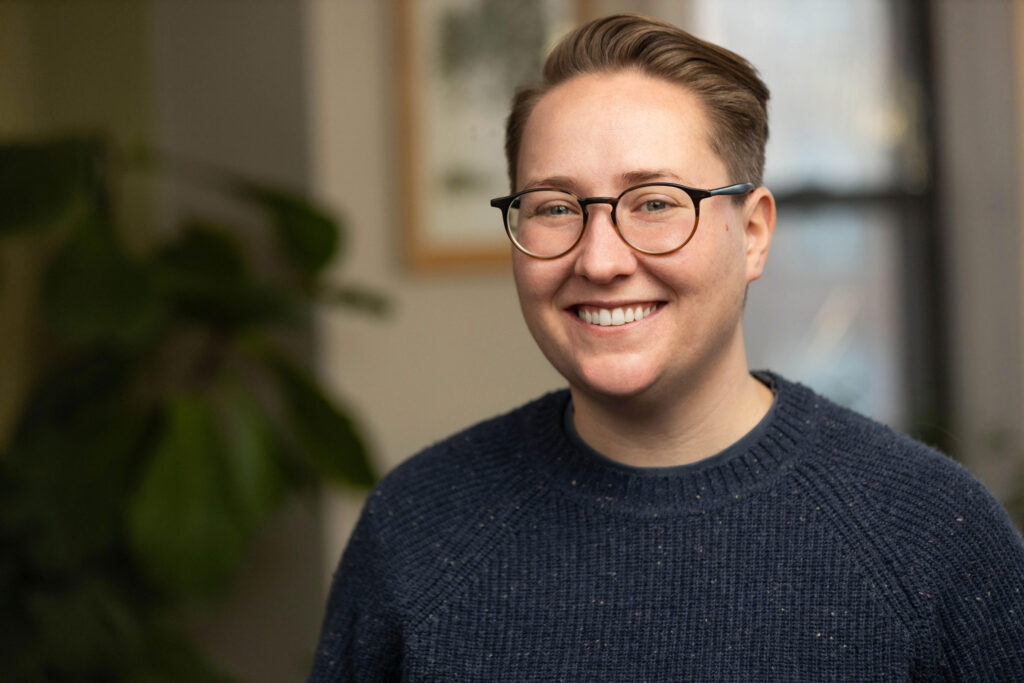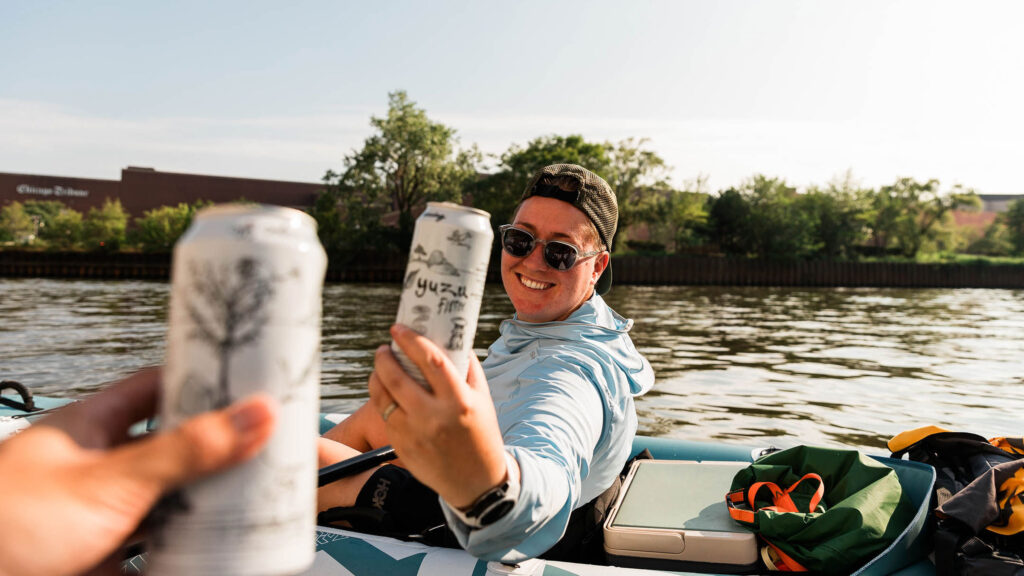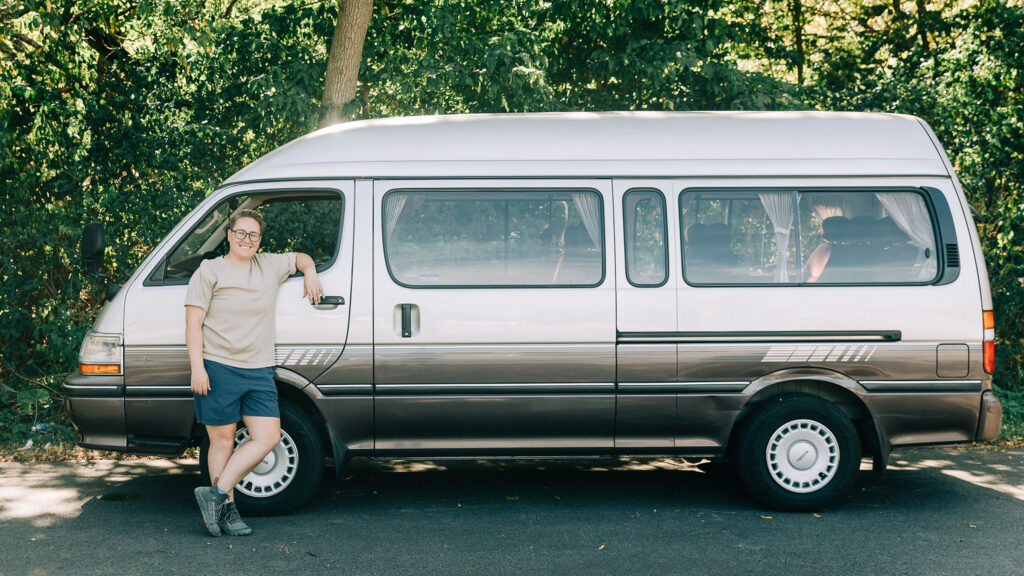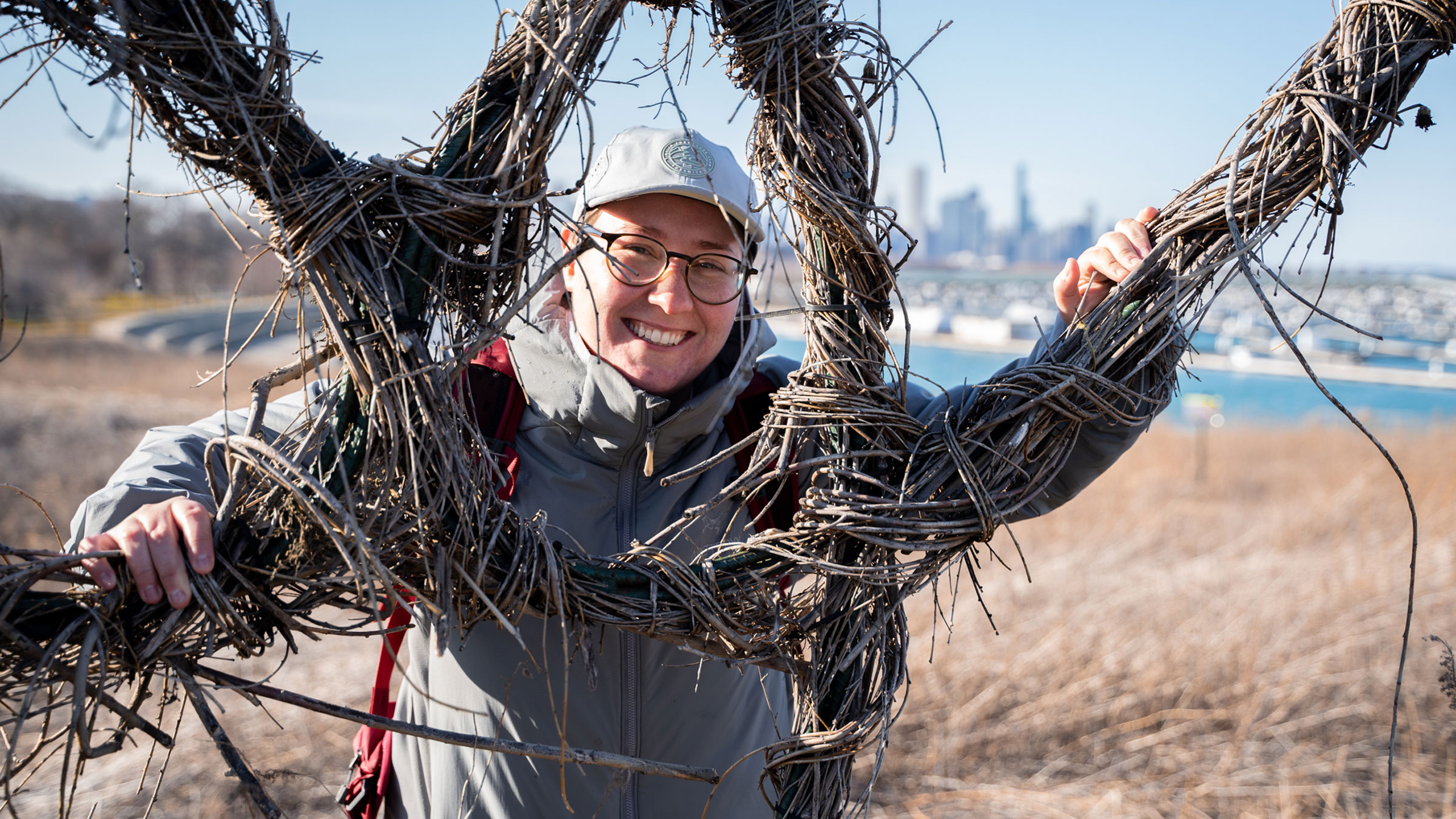Chicago-based freelance outdoor and travel writer Erica Zazo (she/they) has a wide array of skills. Erica fell in love with the outdoors in college at Michigan State University, where she studied journalism and public relations. Moving into the workforce in 2014, Erica got into PR for tech startups as their day job, with freelance writing on the side.
When COVID hit, Erica got burnt out from pitching tech media and found that freelancing allowed them to be a more authentic version of themselves—that’s when freelancing became more than just a side gig. Now, Erica does a mix of journalism, tourism and outdoor marketing, PR, event planning, and tour guiding.
Their most recent endeavors? Starting a part-time hiking and beer tour company in Chicago called Trail to Taproom and being a supporting organizer for the Outdoor Media Summit.
In this interview, we dig into how they started freelancing, what it’s like writing for larger publications, PR trips, their experience being queer in the outdoor industry, and more.
Year started freelancing: 2014, full-time 2022
Age when started freelancing: 22, full-time 30
Preferred Pronouns: she/they

What’s your “about you” elevator pitch for what you do?
I’m a freelance outdoor and travel writer based in Chicago. I also consult with tourism boards and outdoor brands on marketing and storytelling.
What did you do before freelancing?
I was working at tech PR agencies doing media relations for startups. So I was basically pitching startups within Chicago and across the country to tech journalists to try to get them to write about the startup’s new technologies,funding rounds, and things like that.
Going from PR to journalism is the opposite direction from most. Usually, people start as journalists and go into PR as a cushy job. I started with a cushy job and then dove into the unknown. But being a PR person was really good preparation for succeeding as a freelance journalist because it taught me how to write a good pitch and what editors are looking for.
What made you decide to start freelancing?
I think COVID was a big catalyst. I was working from home, totally alone, for nearly two years, which helped me feel comfortable working on my own. I also got very burned out from pitching tech media. At the same time, the outdoors was becoming an even more important part of my life—I just wanted to be outside camping and hiking all the time. I really felt like my true self when I was freelancing on the side, outside of my day job. I noticed how much happier and less stressed I was when freelancing compared to my regular job. Eventually, I think COVID allowed me to burn out in a way that let me flourish as a freelancer.
What was your education before freelancing?
I went to Michigan State University for journalism, and I had a minor in public relations, so I ended up leaning into PR out of college, but then using my journalism degree to freelance and build credibility right out of school.
What was the most challenging thing for you when you first started freelancing?
I would say the most challenging thing was negotiating rates. Looking back, I was really underselling myself early on. I didn’t find (financial) success until I started advocating for myself to be paid what I needed to grow an actual salary. I started negotiating contracts for my brand and marketing work, and for journalism, only taking assignments that were paying me what I needed to survive. Figuring out how much my words were worth—and then believing in myself to defend that worth—was the hardest part.
I do think it’s important to start with smaller assignments and smaller publications to grow. It’s a lot of navigating the balance between publication title and compensation because sometimes the smaller publications actually do pay better (and faster).
On that note, you write for the Outside Inc. group of publications, how did you get into that?
It started when I moved to Texas after college to live in Austin. I was eager to figure out how to get outside and explore the outdoors in the city. One day, my aunt sent me a Facebook post that Backpacker Magazine was looking for Southwest-based writers to cover the outdoors. I had never written for a publication before, but I decided to reach out to the editor at the time, referencing the Facebook post. They ended up assigning me my first story, which was a big deal to be published in one of the bigger magazines in the industry as my first piece. That really helped launch my writing career.
I continue to write for them today—they’re my longest-standing editorial relationship. They were very supportive and allowed me the opportunity to write for them when I was just starting out. It was a very “right place, right time” moment that I took advantage of.
Do you mostly do on-location stories for them, do you pitch your ideas, or do they assign them? How does that work for you?
The first half of my career was me pitching stories after I had done a trip, so it was all on-site. Once my relationship grew stronger, my editors started assigning me stories here and there. I think after they knew who I was, they were more receptive to assigning me stories. Then, my being vocal about wanting assignments helped me continue to get assignments without needing to pitch them all the time.
However, those assignments didn’t start coming through until like five years of working with them. A lot of what I write about now, I still pitch to them—it’s just easier to break through the noise of pitches because I now have strong relationships.
And you write about gear for CNN some too, right? How did that come to pass?
That’s a crazy story, which is also social media-related. The editor found me on Twitter (I refuse to say “X”). I don’t even have a big following or post on it a lot, but I guess I maintain it enough for people to find me. One day, the editor just DM’d me and said they were building out their outdoor and recreation gear column, and asked if I wanted to be a contributor. I was really surprised since I had just been randomly tweeting about my outdoor experiences over the past couple of years of full-time freelancing at that point.
I really started being more vocal on my social accounts when I went full-time freelance because I wanted people to see what I was doing and prove that I was living an outdoor lifestyle. It’s helped me maintain my brand as an outdoor enthusiast and a freelance writer.
Are journalists still on Twitter (X)?
I think they are. I think journalists and editors still live there, and publications still maintain pages. I don’t think anyone wants to be there, but we still are.
Between journalism and marketing, what does your income split look like?
It’s close to half and half. I’ve learned that having a retainer client on the marketing side in either tourism or with a PR agency enables me to maintain a consistent incomet each month. Then, I supplement that retainer client with a handful of stories each month. I’m still figuring out how to find the right balance between the two, but I think the 50-50 is my ideal.

How do you get new ideas to pitch and keep up a steady stream of pitches and ideas going?
I would say the best stories for me are the ones I genuinely want to be doing anyway. I think about the experiences I want to have—like traveling or trying new activities—and then I’ll plan and do those. After the adventure or experience, I have enough to go off of to write a pitch. For example, one story I want to write one day is about crabbing on a kayak along the Pacific Northwest coast. Now it’s time to plan that adventure.
I also write a lot about queer experiences in nature, based on my experiences as a queer person. That includes topics like gender-neutral outdoor gear and apparel, and how brands can better support the queer community. I love to write stories that allow me to advocate for my community, hold the industry accountable, and push them to do better.
I also work to maintain good relationships with PR people, because they often give me intel on upcoming products or opportunities that I can pitch. Staying plugged into that network helps me generate new ideas.
So those three things would be my main ways: writing about what I love to do and drawing on my own experiences, focusing on social issues that matter to me, and then staying in touch with folks who let me in on insights that I can pitch.
So first off, I make it very clear to the brand that if I’m coming, it’s not a guarantee that I’ll write about the story—especially in the exact way that they may want me to. It’s going to be the experience I have with the product that drives the story.
The last couple of years, the PR trips I’ve been on have been very product-focused. So, I’m getting the chance to test the product in the environment they were made to be used.
An example of this is when I went on a trip to Zion with Hoka last spring to hike with their new trail shoes. Because I live in Chicago, I don’t have that much opportunity to hike in the desert with these new breathable Hoka hiking shoes without going there. The trip served as a way for me to experience the product where it was meant to be experienced. From that trip, I wrote about the Anacapa 2 shoe for CNN Underscored.
PR trips have also been a way to help me connect with the brand and meet its ambassadors. A lot of time, press trips will have ambassadors on the trip who are pro athletes and that’s been a really cool experience. Like, when I got to go to Moab with Mountain Hardware and they had Nikki Smith, who’s a trans rock climber. I got to hang out with Nikki Smith and then I ended up including her in my story on pride last summer, how brands can better advocate for the queer community in Gear Junkie.
Do you ever turn down PR trip offers?
Yeah, I do. Sometimes it’s because I just don’t have an interest in covering that sort of product. Other times, I’m too busy to say yes, because that’s time out of the office for me.
Have you ever gotten burnt out from freelancing and if so, how do you manage it?
I think the beauty of being a freelancer is we get to choose what we’re doing and when we do it. So, as soon as I realize I’m burning out, I change the path that I’m on. For example, when I realized I was getting burned out from writing all day, every day last summer, I pivoted to setting a goal to land a marketing retainer client so that I could cut back on some of my stories.
I think constantly pivoting has helped me avoid burnout because when you’re in a corporate setting, your job is your job. It’s kind of hard to change what you do every day. With freelancing comes the stress of figuring out new challenges and making it work, but I think the opportunity to pivot has been really helpful for me to bounce back from burnout.
When you say you’re going to land a new client, how do you normally go about trying to do that?
I have to constantly be networking at all times to have the opportunity to plug into new opportunities. So, several times a week, I’m connecting with random people from my past, I’m trying to meet new folks online via virtual coffees, and I’m making an effort to comment and message people on LinkedIn about what I’m up to these days.
I think new opportunities for clients have been something I’ve been working on for months in the background. I make it a priority to always be telling people in my network that I’m looking for work, and coming up with ways to pitch people creative ideas, even if that might be three to six months from now.
It’s telling people I’m open to opportunities that are not just freelance writing and inserting myself into conversations with people that allow me to ask if I can be a part of what they’re doing—whether that’s a brand marketer, my old bosses, or building new relationships.

What do you think you’re best at as a freelancer?
I would say managing and maintaining relationships. I think you have to be a proactive and helpful person to stay on the radar of people. Maintaining relationships has allowed me to flourish as a freelancer. Whether that’s just following people on Instagram and having a genuine interest in what they’re doing and commenting on their posts/stories, or sending someone an email when I see something that reminds me of them. Even on press trips, just being a nice person and connecting with people on a deeper level than, “Thanks for inviting me on a media trip.”
I would also say multitasking. I’m very ADHD, so I’m able to bounce between different tasks and juggle a lot of balls at once—multiple clients, stories, email accounts, social media, etc. My background in PR prepared me well for that kind of juggling act.
Have you ever experienced any challenges in the outdoor industry?
I would say when PR agencies expect me to only want women’s apparel and products. Like, they don’t even ask, and just assume, that that’s what I want. They don’t recognize that I identify as a nonbinary person even though I very clearly have she/they pronouns on my Instagram and LinkedIn accounts, and have written several stories on this topic.
While I am comfortable in my female identity, I also appreciate and prefer the opportunity to wear gear and try gear that’s not female-gendered.
When you’re pitching me, I don’t want to see only female options, because A, I’m not going to pick that, and B, it’s an instant sign that you’re not tuned into what I’ve written about and how I identify. I think that’s probably the biggest challenge.
I’ve also been trying to write more about fly fishing, and to me, that has definitely been one of the sports that has been so male-dominated. I’ve been on press trips for fly fishing that have not gone well with me being the only female in the room. It’s hard to be the only visibly queer person and the only woman among many super masculine fishermen. I can’t even imagine what it’s like for people of color to be the only person of color in the room.
Now, a lot of times on my fishing trips, I’ll specifically ask for a female or non-binary guide, or a guide of color, to pressure agencies and guiding companies to think differently about who they’re hiring.
If you could give one piece of advice to a woman or non-binary person getting into freelancing, what would it be?
Fill your feed and your network with community. Whether you’re a digital person and have social feeds or you’re in-person networking, build and find a community that you can see and talk to constantly.
For me, personally, I don’t know as many queer writers in the industry (I’m glad I met you, Johanna!). But also just following other badass female freelancers or following athletes who are non-binary, like Nikki Hiltz, has been very helpful to feel in community.
I try to stay connected with this community so that I know I’m not the only one. Similar to TFO, the more you talk to folks who are like you, the more comfortable you feel—and feel like there is a community for you.

Want to get more of Erica Zazo’s work?
You can subscribe to Erica’s newsletter, Staying Curious, read more of her work via her writing portfolio, follow her adventures on Instagram, or join her on a guided beer hike in Chicago with Trail to Taproom!
Some of Erica’s favorite pieces of work:

